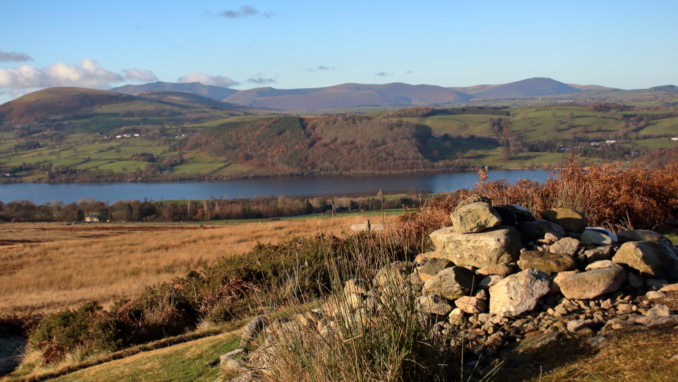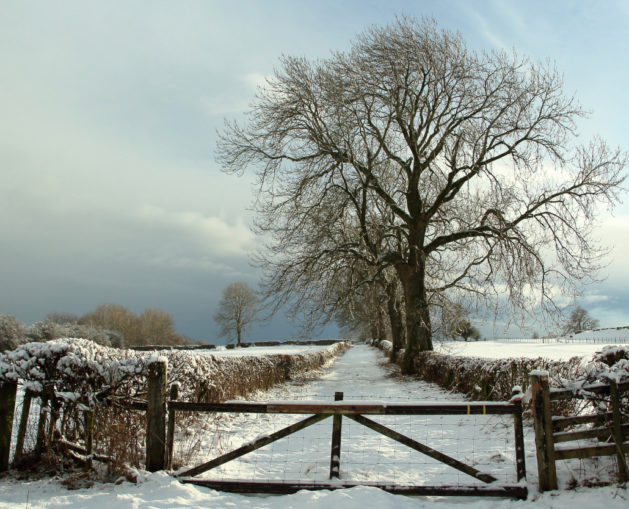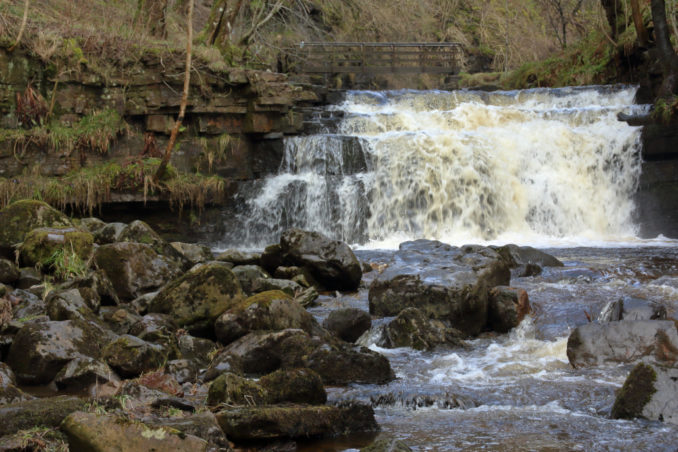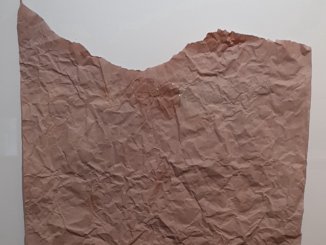
In this second article about photography I wanted to talk about how I take “scenery” photographs, many of which often require setting up and/or travelling specifically to a place to take pictures and others which opportunely present themselves when the camera is to hand. Here I’d like to reiterate that I’m nothing more than a “self taught” enthusiastic amateur who has latterly joined a social camera group which allows myself and other members to learn from each other and, hopefully, improve the content and the quality of our photographs.

Manual Camera Setting. F Stop 8.0. S/S 1/640. ISO 125. 18-55mm lens © Colin Cross, Going Postal 2020
This image is Blencathra, often known colloquially as “Saddleback”, for obvious reasons. I was on my way along the A66, heading for Buttermere, on a lovely day in February this year. I’ve taken lots of pictures of her before but on this particular day this most iconic of Lakeland mountains was looking particularly resplendent in the late morning sunlight. There’s a lay-by a couple of miles east of Threlkeld, so I took the opportunity to pull in and see if I could get a decent picture; I’d been prepared to set up the tripod but the light was good and there was a fence post handy to support bean-bag and camera, meaning I could probably use a quick enough shutter speed to negate any possible wobble. I took half a dozen shots, at a variety of speeds, the main aim being to ensure that Sharp Edge (to the right of the picture) was as clearly defined as possible and the colours were vibrant, whilst retaining a sense of the size of the mountain. This was the pick of the bunch.

Manual Camera Setting. F Stop 9.0. S/S 1/1250. ISO 250. 18-55mm lens © Colin Cross, Going Postal 2020
Composition is important when taking scenery and landscape shots, the aim is to have a finished photograph that is neither too “busy” or lacks depth of field, therefore appearing “flat” to the eye. Often this is where the broad “rule of thirds” can be applied to judge whether or not the composition of any given photograph is aesthetically pleasing to both viewer and the photographer. It isn’t a hard and fast rule, but both in the vertical and particularly the horizontal planes of this picture it can be applied. Water, trees & mountains and cloudy sky all coming together to create a complete winter scene. If I’m picky there’s a little more than a third sky, but a good effort, nonetheless.
When I looked closely at this exposure there was a small dog between the two trees on the far right of the picture, I edited it out by copying a small section of the lake and “brushing” out the animal.

Manual Camera Setting. F Stop 5.6. S/S 1/640. ISO 100. 18-55mm lens © Colin Cross, Going Postal 2020
This picture was taken at Beadnell Harbour in Northumberland, a classic “rule of thirds” photograph which I’ve cropped slightly and leveled up so that one of the masts is in the perpendicular. There’s a symmetry to the boat in the foreground but it doesn’t dominate the picture completely. The sky has its own part to play, the uniform light grey of the cloud broken up by the masts and the lobster pots create perspective against the beach. This shot provides a good example of “depth of field”. Each element of the photograph is as clearly defined as it needs to be and is also relatively in perspective . I like the predominance of the different shades of blue on the boats, which is enhanced by these same shades being softened by the reflection in an almost flat sea.

Manual Camera Setting. F Stop 6.3. S/S 1/2000. ISO 200. 18-55mm lens © Colin Cross, Going Postal 2020
I’m particularly fond of this deceptively simple photograph, I walk past (or along) this lane every day and it constantly changes due to weather, season and light. Its primarily just a field access track now but it leads to a paved road called Coach Gate and there’s an intact bridge spanning it, about a mile along, from when the Penrith to Keswick line was operating. I like to imagine that it may once have been a well travelled route at some time in the past. To get this picture, which I’d been planning for some time, I waited until we’d just had a decent snowfall (you can see the snow clouds moving north east in the picture), walked the quarter mile or so and set up my tripod a couple of feet above the ground. Using the top spar of the gate as an approximate level reference point I set the camera to what I thought would be the correct settings to achieve the result I wanted, attached it to the tripod, lined the viewfinder and zoom up, set the camera timer for 10 second delay to negate wobble and let the equipment do it’s work. Again here the rule of thirds works, particularly in the horizontal.

Manual Camera Setting. F Stop 13.0. S/S 1/200. ISO 250. 18-55mm lens © Colin Cross, Going Postal 2020
We holidayed on the west coast of Scotland in May last year and I’d promised myself that, should the opportunity arise, I’d get a picture of a sunset. I’d seen professional examples and wanted to have a go myself. Getting the settings right on the camera so as to avoid too much light but still allow for a defined finished photograph at night involves a bit of planning, the right place and time and not a little luck. It was after 10pm when I got this picture, I’d set out with tripod, expecting to set up on the beach for the best shot, in the end I lay out flat on a dune just above the beach, which allowed me to get the suns reflection off the sea and also to allow as much of the sky as possible to feature. Basic rule of thirds again. The Isle of Eigg is captured in the glow from the setting sun.

Manual Camera Setting. F Stop 11.0. S/S 1/80. ISO 400. 18-55mm lens © Colin Cross, Going Postal 2020
This photograph and the one below are two in a series of six which I took at varying F/Stop and shutter speeds (F5.6 1/200 to F25 1/4). The aim being to reach the optimum setting to create the “curtain of water” effect whilst maintaining focus. I’ve enhanced the brightness a little on the one above and cropped the one below but both were taken using the tripod and the timer function to ensure no camera wobble, resulting in an out of focus picture, which can happen with slower shutter speeds and is inevitable once the speed gets below 1/50 or so, unless there’s an extremely steady hand in play.

Manual Camera Setting. F Stop 25.0. S/S 1/4. ISO 100. 18-55mm lens © Colin Cross, Going Postal 2020
In my opinion each of these two pictures has some merit, they are both decently composed, although the rule of thirds isn’t in too much evidence. The focus is good and I like the flat boulder, which, I feel, holds the images together. The lower picture is about displaying technique as much as anything else. One of the most difficult things to do when taking photographs of water is to create an image which imparts the impression of fluid movement. Given where I live I’m able to get plenty of practice at that.

Manual Camera Setting. F Stop 18.0. S/S 1/4. ISO 100. 10-18mm lens © Colin Cross, Going Postal 2020
To get this shot I moved down the bank 50 yards or so and switched to my wide angle lens, keeping the camera on the tripod and maintaining the 10 second timer function. I wanted to get the colour of the beck into the picture as the water cleared the small rapids and continued its flow down the valley. In editing I used the grid levelling tool to straighten the final picture up and upped the brightness a notch but otherwise this is “as shot”.

Manual Camera Setting. F Stop 10.0. S/S 1/25. ISO 150. 18-55mm lens © Colin Cross, Going Postal 2020
Lots of pictures of water, I know, but this final photograph, taken at Ghyll Wood Beck in Buttermere is, in my opinion, an example of creating an image of water that imparts the elusive fluidity of movement I mentioned above, whilst still showing some photographic technique, if you get my drift.
Key to Terminology
DSLR; Digital Single Lens Reflex camera
F Stop; The F Stop relates to the size of the aperture in the lens of a camera related to the focal length. If you had a zoom set at 40mm with an aperture of f/8, the diameter of the aperture opening would be 5mm (40 divided by 8). It determines the amount of light entering the camera when a photograph is taken.
S/S; Shutter speed is simply the speed at which the shutter opens and closes. Generally, the faster the shutter speed, the higher the F number required to optomise the light.
ISO; ISO is a settable function (I always set to auto) that amplifies the light signal generated by the combination of F Stop and shutter speed.
AF; The AF Point Selection allows the camera to indicate when any number of points within the target are in focus, setting this to Manual allows the photographer to select one single point of focus.
MANUAL; Selecting the Manual setting on the function wheel allows more control over the finished results. Generally the best way of getting a “feel” for a camera.
RAW; A settable function on any DSLR which allows greater control over any editing, images taken in RAW can easily be converted to J Peg. All above images are converted from RAW.
NB; This information relates primarily to the Canon “D” range of cameras. Other makes will have broadly the same functions.
Every DSLR will have one or more Auto Picture taking settings on the main function wheel. Using these will allow the camera to take the picture it wants to take, rather than the picture you might want it to take, the result may not be as good as you hoped it might. Taking pictures in Manual setting, which allows the setting of focal length, shutter speed and F Stop generally means better results. The camera will indicate when you are close to optimum focus (usually this is a simple line graph on the camera screen) allowing you to experiment but also be more “in charge” of the finished photograph.
© Colin Cross 2020
The Goodnight Vienna Audio file



